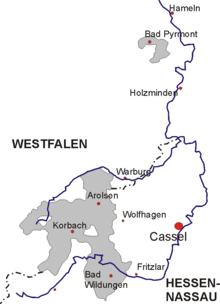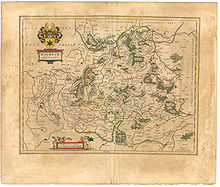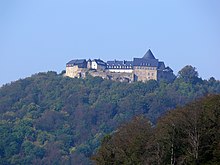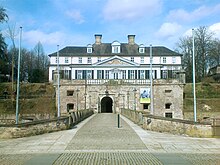Waldeck
|
||||||||||||||||||||||||||||||||||||||||
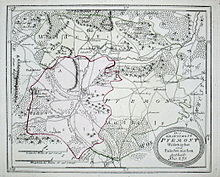
The state of Waldeck emerged in the Middle Ages around Waldeck Castle on the Eder in the northwest of today's state of Hesse as an independent county of the Holy Roman Empire . In 1712 it became a principality with the residence town of Arolsen (today Bad Arolsen ), which was also united with the county of Pyrmont zu Waldeck-Pyrmont from 1848 to 1921 . The Counts and Princes of Waldeck came from the Waldeck family .
As a result of the November Revolution of 1918, the principality became a free state. In 1921 Pyrmont was separated again and incorporated into Prussia ; the remaining Free State of Waldeck was dissolved in 1929 when it was incorporated into the Prussian province of Hessen-Nassau .
From 1942 to 1974 there was once again a regional authority with what was then the district of Waldeck , whose territory roughly corresponded to the former Free State and which was then merged into the newly formed district of Waldeck-Frankenberg in Hesse .
coat of arms
Blazon of the Waldeck family coat of arms : “An eight-pointed black star in gold . On the helmet with black and gold covers an open golden flight , each with a star . "
Original coat of arms of the Waldeck family: “An eight-pointed black star in gold. On the helmet with black and gold covers, a shield-like umbrella board with seven gold feathers , with the eight-pointed black star in gold. "
Open flight developed from the feather umbrella board.
Waldeck-Pyrmont: large national coat of arms
The large state coat of arms of the principality has a twice split and twice divided shield with an applied heart label , which shows the old coat of arms of the principality of Waldeck. The coat of arms of the County of Pyrmont appears in the first and ninth fields, the coat of arms of the Rappoltstein rulership in the second and eighth fields (to which the Waldeck princes only vaguely justified claims since 1793), and the coat of arms of the Hohenach / Hohenack rulership in the third and seventh fields (both in Alsace ), in the fourth field the coat of arms of the Tonna rule in Thuringia (which belonged to Waldeck from 1640 to 1677), and in the sixth field the coat of arms of the Geroldseck rule (this is Grand-Geroldseck in Alsace, not Hohengeroldseck in the Ortenau district).
Five spangle helmets rest on the shield :
- Reign of Hohenach
- Rappoltstein
- Waldeck and Pyrmont
- Tonna
- Geroldseck
Two golden lions, standing on an ornament, around which a black ribbon with the motto “PALMA SUB PONDERE CRESCIT” (The palm tree grows under the load) is wrapped as a sign bearer.
Data
- Flag: black-red-gold since 1848
- Capital: 1655–1918 Arolsen
- Residence: 1180–1655 Waldeck Castle , 1655–1918 Arolsen Castle
- Form of government: County, from January 1712 Principality , from 1918 Free State
- Population: 56,224 (1871), 55,816 (1925)
- Founding: 1180 County of Waldeck, 1625 County of Waldeck and Pyrmont, 1712 Principality of Waldeck-Pyrmont
- Heimatlied: My Waldeck
history
origin
Ancestors of the Counts of Waldeck and later princes of Waldeck and Pyrmont were the Counts of Schwalenberg in the male line (with Widekind I. as the progenitor).
The castle Waldeck over the Eder is first attested in 1120. A branch of the Counts of Schwalenberg named themselves after this castle from 1180, after Volkwin II. Von Schwalenberg built the castle through his marriage to Luitgard, the daughter of Count Poppo I. von Reichenbach and Hollende and heiress von Waldeck. In the course of history this family succeeded in building up a small area of dominion in what is now northern Hesse .
County of Waldeck until 1712
Initially, Waldeck was a fiefdom of the Archdiocese of Mainz . In 1379 the county became an imperial fief. After the death of Count Heinrich VI. In 1397 the family split into two lines, the older Landau line with Adolf III. and the Waldecker line with Henry VII , who even feuded with each other at times. Both lines came under the feudal sovereignty of the Landgraviate of Hesse in 1431 and 1438 - but also under the impression of the final landgrave victory over Kurmainz in 1427 and the fiefdom of the County of Ziegenhain in Hesse (from 1576 Hesse-Kassel ). The Landgrave paid the Counts of Waldeck a loan to repay their debts and also took over their remaining debts.
In 1486, after the death of Henry VIII, the Waldecker line split again into the Waldeck-Wildungen and Waldeck-Eisenberg lines . When the older Landau line expired in 1495 with Otto IV , their property went back to the Wildungen and Eisenberg lines. In 1526 and 1529, Philip IV of Waldeck-Wildungen and Philip III. von Waldeck-Eisenberg introduced the Reformation . Several divisions of the estate led to the emergence of other different lines and subsidiary lines, which were reunited in 1692 by the newer Wildunger line.
In 1625 the County of Pyrmont also came to the Counts of Waldeck by inheritance contract , who from then on called themselves Counts of Waldeck and Pyrmont . A union of the two spatially separated domains in the constitutional sense did not take place until the 19th century.
In 1639 Count Philipp Dietrich von Waldeck from the new Eisenberger line became heir of the last Count von Pallandt -Culemborg and took over the county of Culemborg in Gelderland with the dominions of Werth in Münsterland , Palant and Wittem . He was followed in 1664 by his brother Count Georg Friedrich zu Waldeck ; he called himself accordingly "Georg Friedrich Graf and Mr. Waldeck, Pyrmont and Cuylenburg, Freiherr zu Tonna, Paland, Wittem, value." In 1682 he was Emperor I. Leopold as a prince of Waldeck in the Imperial Prince collected. After his four sons had all died before him, on June 12, 1685 he introduced the Primogenitur in the entire Waldeck house by contract with his cousin, Count Christian Ludwig from the newer Wildunger line . Emperor Leopold I confirmed this contract in 1697. After Georg Friedrich's death in 1692, Christian Ludwig became sole ruler of the entire county.
The county Cuylenburg and the rule Werth fell in 1714, due to the marriage of Georg Friedrich's second daughter Sophia Henriette (1662–1702) with Duke Ernst von Sachsen-Hildburghausen , in November 1680 , to Sachsen-Hildburghausen. In 1640 the Tonna lordship in Thuringia came to Waldeck-Pyrmont through inheritance as a fief of the dukes of Saxony-Altenburg ; however, it was sold to Duke Friedrich I of Saxe-Gotha-Altenburg in 1677 .
Principality of Waldeck 1712 to 1848
Friedrich Anton Ulrich von Waldeck and Pyrmont was on January 6, 1712 by Emperor Karl VI. raised to the hereditary prince status and called himself Prince of Waldeck and Pyrmont ever since.
During the American War of Independence from 1775 to 1783, Prince Friedrich Karl August made three regiments available to the British for battle in America against payment . A total of 1225 Waldeck soldiers fought in America.
The turmoil at the turn of the 18th to the 19th century survived the principality, which had joined the Rhine Confederation in 1807 without being incorporated into the Napoleonic Kingdom of Westphalia . Waldeck had to undertake to ensure equality for Catholic citizens in their religious practice and to provide 400 soldiers in the event of a campaign. A short-term division of the estate in 1806 between the brothers Friedrich and Georg ended after only six years with Friedrich's death.
In 1815 Waldeck joined the German Confederation , in 1832 the German Customs Union . In 1847, at the instigation of Prussia , the feudal sovereignty of Hessen-Kassel over Waldeck (as well as Schaumburg-Lippe ) was finally revoked by an arbitration award of the Bundestag , after this had already been effectively resolved by Waldeck's accession to the Rhine Confederation in 1807. For Hessen-Kassel this was a loss, because it could no longer claim a right of repatriation.
Principality of Waldeck-Pyrmont 1849 to 1918
As early as 1813 the prince had tried since 1645 in personal union mitregierte County Pyrmont (since 1807 Principality) with Waldeck the Principality of Waldeck-Pyrmont to unite constitutional law, but what is actually managed by political opposition until the 1849th But even after that, until 1863/64, there was a small state parliament in Pyrmont specifically for budget law. (For the state's court system, see Courts in the Principality of Waldeck and Pyrmont .)
On August 1, 1862, Waldeck-Pyrmont concluded a military convention with Prussia. Therefore, in the war of 1866 between Prussia and Austria, it was on the side of Prussia and thus avoided annexation (in contrast to the neighboring Electorate of Hesse ) .
Since the small and financially weak principality could not pay its contributions to the North German Confederation , the state parliament unanimously rejected the federal constitution in order to urge the prince to sign an accession agreement with Prussia. Bismarck had previously rejected the idea of a union with Prussia for reasons of prestige. As a result, Waldeck-Pyrmont concluded the accession agreement with Prussia in October 1867, according to which the principality remained nominally independent, but from January 1, 1868, Prussia took over the state deficits and internal administration with the justice and school system of the principality, albeit in accordance with Waldeck's laws. Since then, Prussia has appointed a state director with formal agreement with the prince. The jurisdiction was exercised by the Prussian regional courts in Kassel and, for the Pyrmont region, in Hanover. The prince was only left with the administration of church affairs, the right to pardon and the right to approve laws. He also continued to receive the income from the domains. The contract was subsequently renewed every ten years. Waldeck thus also remained a federal state of the federal government expanded to form the German Empire .
Free State of Waldeck-Pyrmont 1919 to 1921
After the end of the First World War , the last ruling prince, Friedrich (1865–1946), was declared deposed on November 13, 1918 by representatives of the Kassel workers 'and soldiers' councils who had traveled there. The previous principality of Waldeck-Pyrmont became a free state within the Weimar Republic . However, no new constitution was subsequently created, so the monarchical constitution of 1849/1852 remained formally in force until 1929. The provisions of Akzessionsvertrages with Prussia also remained in force even after the county Pyrmont separated on 30 November 1921 after a referendum, and as part of a treaty with Prussia the Prussian province Hannover associated with the district Hameln to Hamelin-Pyrmont district was combined .
Free State of Waldeck 1921 until dissolution in 1929
It was not until 1926 that the Free State of Prussia canceled the accession agreement. Since Waldeck was no longer financially viable without unreasonable tax increases after the amendment of the Financial Equalization Act on April 9, 1927, which meant a reduction in the Reich tax allocations by almost 600,000 Reichsmarks, the Free State of Waldeck was dissolved on April 1, 1929 and became part of the province of Hesse- Nassau incorporated into Prussia. Waldeck ceased to exist as an independent state.
Further development after 1929
With the transition to Prussia in 1929, the three districts of Waldeck, which had already been formed in 1849/50, the district of Eder , Eisenberg and Twiste , initially continued to exist. The previous enclaves Höringhausen and Eimelrod , which had fallen to Prussia from the Grand Duchy of Hesse as exclaves of the Vöhl district in 1866 , were incorporated into the Eisenberg district. The Reich government ( Papen cabinet ) merged the Eder and Eisenberg districts in 1932, and the Twiste district was to be merged on April 1, 1934 with the neighboring Wolfhagen district with its administrative headquarters in Arolsen. This did not happen after the Nazi takeover of power in 1933. A law of February 28, 1934 repealed the merger of Eder-Eisenberg and the planned merger of Twiste-Wolfhagen.
On February 1, 1942, the three Waldeck districts were combined to form the new Waldeck district with the district town of Korbach . This gave rise to another regional body that bore the name Waldeck and whose area roughly coincided with that of the earlier principality. As part of the Prussian province of Hessen-Nassau (from 1944 province of Kurhessen ), the district of Waldeck became part of the new state of Greater Hesse in 1945 , which in 1946 became today's state of Hesse .
In the course of the Hessian regional reform of 1974, the Waldeck district was merged with the neighboring Frankenberg district to form the new Waldeck-Frankenberg district. However, the city of Züschen lost its centuries-old affiliation to Waldeck and became a district of the city of Fritzlar in the Schwalm-Eder district .
Internal administrative structure of the state of Waldeck
By 1814 Waldeck was divided into nine offices , which also included the 13 mostly small towns : Arolsen (previously Mengeringhausen ), Eilhausen , Eisenberg , Landau , Lichtenfels , Rhoden , Waldeck , Wetterburg and Wildungen . In 1814 these were merged into three higher offices and in 1816 they were divided into five higher justice offices: Rhoden and Eilhausen were combined to form the higher justice office of the Diemel , based in Rhoden; Arolsen, Wetterburg and Landau were combined in the Twiste Higher Justice Office , with headquarters in Arolsen; Waldeck went on in the higher justice office of the advertising , with seat in Sachsenhausen ; and Wildungen became the chief justice office of the Eder , based in Alt-Wildungen. Lichtenfels (based in Sachsenberg ) remained independent until 1848, but was then absorbed into the Eisenberg's higher justice office .
In 1849/1850 the principality was divided into three districts: the Eder district (seat in Wildungen), the Eisenberg district (seat in Korbach ) and the Twiste district (seat in Mengeringhausen , from 1857 in Arolsen). The upper offices of Eder and advertising as well as Freienhagen , which was separated from the upper office of Twiste , became the circle of Eder. Strothe and Meineringhausen came to the Eisenberg district. The upper offices of the Twiste and the Diemel became the Twiste circle. Then there was the Pyrmont district (united with the Prussian Hameln district (province of Hanover) from 1922 ).
List of regents and heads of government
Counts and Princes of Waldeck
Count of Waldeck
- 1137–1185: Volkwin I.
- 1185–1209: Heinrich I.
- 1185-1189: Widukind III.
- 1185-1223: Hermann III.
- 1224–1249: Volkwin II.
- 1218–1270: Adolf I.
- 1270-1271: Adolf II.
- 1271–1305: Otto I.
- 1305–1344: Henry IV.
- 1344-1369: Otto II.
- 1369-1397: Henry VI.
Division into Waldeck to Landau and Waldeck to Waldeck
Counts of Waldeck zu Landau (older line)
- 1397-1431: Adolf III.
- 1431-1459: Otto III.
- 1459–1495: Otto IV.
Extinction of the older Landau line; Waldeck-Landau falls to Waldeck-Eisenberg and Waldeck-Wildungen
Counts of Waldeck to Waldeck (newer line)
- 1397–1444: Henry VII.
- 1442 / 44–1475: Wolrad I.
- 1475: Philip I.
- 1475–1486: Henry VIII (guardian and regent: Philip II )
1486 division into Waldeck-Eisenberg and Waldeck-Wildungen
Counts of Waldeck-Eisenberg (older line)
- 1486–1524: Philip II.
- 1524-1539: Philip III.
Division into Waldeck-Eisenberg middle line and Waldeck-Landau newer line
Counts of Waldeck zu Landau (newer line)
- 1539–1567 Johann I.
- 1567–1579 Philip VI.
- 1579–1597 Franz III.
1597 expiry of the newer Landau line; Waldeck-Landau falls to Waldeck-Eisenberg and Waldeck-Wildungen
Counts of Waldeck-Eisenberg (middle line)
- 1539–1578: Wolrad II.
- 1578–1588: Josias I.
- 1588–1607: Christian (1607 founder of the newer Wildunger line)
- 1588–1607: Wolrad IV. (Christian co-regent, 1607 founder of the newer Eisenberg line)
1607 Division into Waldeck-Eisenberg (newer line) and Waldeck-Wildungen (newer line)
Counts of Waldeck-Eisenberg (newer line)
- 1607–1640: Wolrad IV. (Until 1607 Christian's co-regent in Waldeck-Eisenberg)
- 1640–1645: Philipp Dietrich (also Philipp Theodor)
- 1645–1664: Heinrich Wolrad
- 1664–1692: Georg Friedrich
Georg Friedrich was raised to the rank of personal imperial prince on June 17, 1682 by Emperor Leopold I. After his death, his sub-county passed to Christian Ludwig von Waldeck-Wildungen by inheritance, who thus reunited both parts of the county in one hand.
Counts of Waldeck-Wildungen (older line)
- 1486–1512: Henry VIII.
- 1513–1574: Philip IV.
- 1574-1577: Daniel
- 1577: Henry IX.
- 1577–1585: Günther
- 1585–1598: Wilhelm Ernst
Counts of Waldeck-Wildungen (newer line)
- 1607–1637: Christian (until 1607 Count von Waldeck-Eisenberg (middle line))
- 1638–1645: Philip VII.
- 1645–1706: Christian Ludwig
- 1645–1669: Josias II (formally co-regent of Christian Ludwig in three offices)
Count of Waldeck
- 1692–1706: Christian Ludwig
Counts of Waldeck and Pyrmont (Haus Waldeck)
- 1706–1712: Friedrich Anton Ulrich ( raised to hereditary prince status by Emperor Karl VI in 1712 ; had Pyrmont Castle built between 1706 and 1710 and Arolsen Castle from 1710 to 1728 and completed the construction of Friedrichstein Castle in Wildungen by 1714 )
Princes of Waldeck and Pyrmont
- 1712–1728: Friedrich Anton Ulrich
- 1728–1763: Karl August Friedrich (during the War of the Austrian Succession also Commander-in-Chief of the Dutch Army)
- 1763–1812: Friedrich Karl August (until 1766 under guardianship, from 1805 after division of the estate only Prince of Waldeck)
- 1812–1813: Georg I (1805–1812 Prince of Waldeck and Prince of Pyrmont)
- 1813–1845: Georg II. Heinrich
- 1845-1893: Georg Victor
- 1893-1918: Friedrich
Heads of the House of Waldeck-Pyrmont
Heads of Government 1654 to 1867
Prussian state directors 1868–1914
- 1868–1872: Julius Adalbert von Flottwell
- 1872–1881: Karl Albert Friedrich Hugo von Sommerfeld
- 1881–1884: Jesco von Puttkamer
- 1885–1886: Ernst von Saldern
- 1886–1907: Ernst Friedrich Johannes von Saldern
- 1907–1908: Leo Marquard von Lützow
- 1908–1914: Ernst Reinhold Gerhard von Glasenapp
Heads of government of the Free State of Waldeck-Pyrmont in the Weimar Republic
- 1918–1920: Karl Hermann Friedrich Wilhelm von Redern
- 1920–1929: Wilhelm Schmieding , DVP
- 1929: Herbert Herberg
Parliament
Land estates existed in Waldeck since the formation of the principality . These existed with minor modifications during the first half of the 19th century. With the March Revolution of 1848, a joint state parliament was created for Waldeck-Pyrmont . During the Weimar Republic there was a state representation as a state parliament.
State representation 1919–1925
| year | ||||||||||||
|---|---|---|---|---|---|---|---|---|---|---|---|---|
| 1919 | SPD | 30.4% 7 seats | DNVP | 23.2% 6 seats | DDP | 21.2% 4 seats | Waldeckischer Volksbund | 13.6% 3 seats | DVP | 7.1% 1 seat | ||
| 1922 | Waldeck regional electoral association ( Landbund / DNVP / DVP / Handwerkerbund) | 50.2% 9 seats | SPD | 20.9% 4 seats | DDP | 12.9% 2 seats | Waldeck Association | 8.7% 1 seat | USPD | 7.4% 1 seat | ||
| 1925 | Landbund | 33.5% 7 seats | SPD | 18.6% 3 seats | DNVP | 16.1% 3 seats | Craftsmen Association | 12.1% 2 seats | DVP | 9.6% 1 seat | DDP | 6.7% 1 seat |
100% missing votes = nominations not represented in the state representation
See also
Historical sources
The extensive written records of the county, the principality and the Free State of Waldeck from the 11th to the 20th century are kept in the Hessian State Archives in Marburg . The documents, files as well as maps and plans have been gradually transferred from Arolsen to Marburg for the purpose of archival indexing since the late 19th century. After Waldeck joined the Prussian province of Hesse-Nassau in 1929, the documents remained permanently in the Marburg State Archives.
literature
- Ulrich Bockshammer: Territorial history of the county of Waldeck . Writings of the Hessian Office for Historical Regional Studies, N. G. Elwert Verlag, Marburg 1958.
- Michael Bohle: Social structure, social change and political decision-making in the Principality of Waldeck 1871-1914 . Self-published by the Waldeckisches Historisches Verein , ISBN 3-9802226-4-0 .
- Eckhard Werner Budach: The Principality of Waldeck in the time of the German Confederation: Studies on the constitutional history of the small states from 1815 to 1866: the relationships of the Principality of Waldeck to the German Confederation and its individual members, especially Prussia, as well as the internal constitutional development of the state. Dissertation . Law Faculty of the University of Kiel, 1974.
- Karl Ernst Demandt : History of the State of Hesse. 2nd Edition. Kassel 1972, ISBN 3-7618-0404-0 , pp. 521-533.
- The Waldeck district: history - landscape - economy . Gerhard Stalling AG Wirtschaftsverlag, Oldenburg 1968.
- Eckhart G. Franz : The Chronicle of Hesse. Chronik Verlag, ISBN 3-611-00192-9 .
- Heinrich Hochgrebe: Waldeckische Bibliography . Waldeckischer Geschichtsverein, Bad Arolsen 1998. Prepared for presentation on the Internet by Jürgen Römer 2010 ( PDF file ).
-
Thomas Klein (Hrsg.): Outline of the German administrative history 1815-1945. Johann Gottfried Herder Institute, Marburg / Lahn;
Row B: Central Germany (except Prussia);- Volume 16: Central Germany (smaller countries). 1981, ISBN 3-87969-131-2 .
- V part: Waldeck. edited by Thomas Klein.
- Volume 16: Central Germany (smaller countries). 1981, ISBN 3-87969-131-2 .
- Gerhard Menk : The End of the Free State of Waldeck - Limits and Possibilities of Small State Existence in the Empire and Weimar Republic. 2nd Edition. Waldeckischer Geschichtsverein e. V., Bad Arolsen 1998, ISBN 3-932468-04-X .
- Gerhard Menk: Waldeck's contribution to today's Hesse (= Hesse. Unity from diversity. 4). 2nd Edition. Wiesbaden 2001, ISBN 3-927127-41-8 (with extensive literature and family tables).
- Arnulf Scriba: The Principality of Waldeck 1815-1848. Political, economic and social conflicts of a small state in Vormärz (= Waldeck research. 14). Bad Arolsen 2007, ISBN 978-3-9808625-7-8 .
- Johann Adolph Theodor Ludwig Varnhagen : Basis of the Waldeck country and regent history. Vandenhoeck & Ruprecht, Göttingen 1825–1853 ( Paderborn University Library ).
- Helga Zöttlein: dynasty and sovereignty. Political change in the county of Waldeck between 1680 and 1730 . Bad Arolsen 2004, ISBN 3-932468-12-0 .
- Jakob Christoph Karl Hoffmeister: Historical-genealogical handbook about all counts and princes of Waldeck and Pyrmont since 1228. Klaunig, Cassel 1883 ( digitized version ).
- Carl Eduard Vehse: History of the German courts since the Reformation, p. 223ff. Section The count's branch lines Waldeck-Pyrmont, Bergheim and Waldeck-Pyrmont-Limpurg.
Web links
- House Laws of Waldeck-Pyrmont (English), with the most important house laws (German)
- Principality of Waldeck
- Principality of Waldeck (districts and municipalities) 1910
- Waldeck coins and the history archive of the regents
- The Free State of Waldeck at a glance
- Church regulations of the Waldeck rule from 1556
- History and map of the principality of Waldeck 1789
- Lexicon of noble free sexes
- Genealogy of the Middle Ages: Family of the Counts of Waldeck
- Coat of arms of the Counts of Waldeck in the Book of Arms of the Holy Roman Empire , Nuremberg around 1554–1568
Individual evidence
- ↑ Johann Adolph Theodor Ludwig Varnhagen: Basics of the Waldeckische Regentengeschichte, Vol. 1. Göttingen 1824, No. 88.
- ↑ Thomas Brückner: Lehnsaufung. Inaugural dissertation . Law Faculty of the Bavarian Julius Maximilians University, Würzburg 2002, p. 68.
- ↑ Waldeck's Accession Agreement to the Rhine Confederation, April 18, 1807
- ^ Frank-Lothar Kroll: History of Hesse. C. H. Beck, Munich 2006, ISBN 3-406-53606-9 , p. 77.
- ^ State treaty between Prussia and Waldeck-Pyrmont on the unification of the Pyrmont area with Prussia of November 29, 1921 ( Preuss. GS 1922, p. 37, Waldeckisches Regierungsblatt. 1922, p. 55, Collection of adjusted Lower Saxony law, Volume II, p 7).
- ^ Philipp Dietrich
- ^ Wildungen, Wetterburg, Landau




